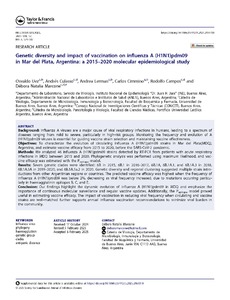Por favor, use este identificador para citar o enlazar este ítem:
https://repositorio.uca.edu.ar/handle/123456789/19974| Título: | Genetic diversity and impact of vaccination on influenza A (H1N1)pdm09 in Mar del Plata, Argentina: a 2015–2020 molecular epidemiological study | Autor: | Uez, Osvaldo Culasso, Andrés Lerman, Andrea Cimmino, Carlos Campos, Rodolfo Marcone, Débora Natalia |
Palabras clave: | VACUNACION; INFLUENZA; DIVERSIDAD GENETICA; EFICACIA | Fecha de publicación: | 2025 | Editorial: | Taylos & Francis | Resumen: | Background: Influenza A viruses are a major cause of viral respiratory infections in humans, leading to a spectrum of diseases ranging from mild to severe, particularly in high-risk groups. Monitoring the frequency and evolution of A (H1N1)pdm09 viruses is essential for guiding vaccine strain selection and maintaining vaccine effectiveness. Objectives: To characterize the evolution of circulating influenza A (H1N1)pdm09 strains in Mar del Plata(MDQ), Argentina, and estimate vaccine efficacy from 2015 to 2020, before the SARS-CoV-2 pandemic. Methods: We analyzed 46 influenza A (H1N1)pdm09 strains detected by RT-PCR from patients with acute respiratory infections in MDQ between 2015 and 2020. Phylogenetic analysis was performed using maximum likelihood, and vaccine efficacy was estimated with the Pepitope model. Results: Seven genetic clades were identified: 6B in 2015, 6B.1 in 2016–2017, 6B.1A, 6B.1A.1, and 6B.1A.3 in 2018, 6B.1A.5A in 2019–2020, and 6B.1A.5a.2 in 2020. Genetic diversity and regional clustering suggested multiple strain introductions from other Argentinian regions or countries. The predicted vaccine efficacy was highest when the frequency of influenza A (H1N1)pmd09 was below 2%, decreasing as viral frequency increased, due to mutations occurring particularly in haemagglutinin epitopes B, C, and E. Conclusion: Our findings highlight the dynamic evolution of influenza A (H1N1)pdm09 in MDQ and emphasize the importance of continuous molecular surveillance and regular vaccine updates. Additionally, the Pepitope model proved useful in estimating vaccine efficacy. The impact of vaccination in reducing viral frequency when circulating and vaccine strains are well-matched further supports annual influenza vaccination recommendations to minimize viral burden in the community. | URI: | https://repositorio.uca.edu.ar/handle/123456789/19974 | DOI: | 10.1080/23744235.2025.2466118 | Derechos: | Atribución-NoComercial-CompartirIgual 4.0 Internacional | Fuente: | Infectious Diseases. 57(6), 2025. |
| Aparece en las colecciones: | Artículos |
Ficheros en este ítem:
| Fichero | Descripción | Tamaño | Formato | Login |
|---|---|---|---|---|
| genetic-diversity-impact.pdf | 1,48 MB | Adobe PDF | SOLICITAR ACCESO | |
| genetic-diversity-impact.jpg | 398,11 kB | JPEG |  Visualizar/Abrir |
Este ítem está sujeto a una Licencia Creative Commons

